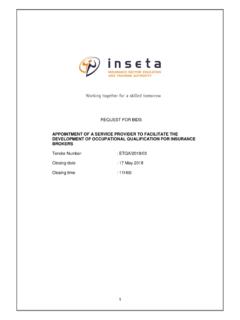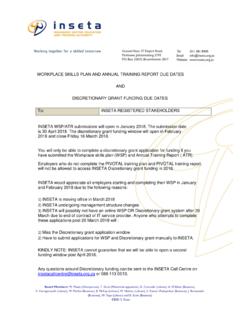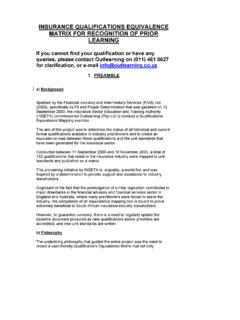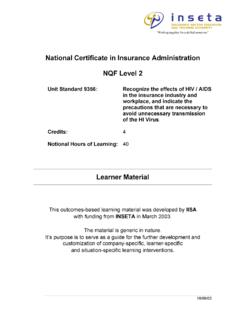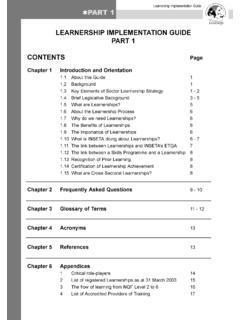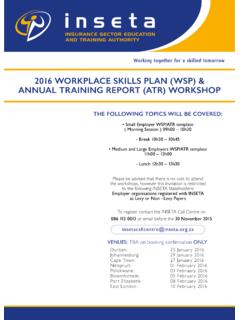Transcription of Framework for National Skill Development Strategy 2011/12 ...
1 NSDSIII Framework , DRAFT (1) FOR CONSULTATION, 29/04/10 Page 1 Framework FOR THE National skills Development Strategy 2011 /12 2015/16 FIRST DRAFT FOR CONSULTATION, 29th APRIL 2010 NSDSIII Framework , DRAFT (1) FOR CONSULTATION, 29/04/10 Page 2 TABLE OF CONTENTS LIST OF ACRONYMS .. 4 1. Background and Legal Context .. 5 2. Ending Poverty Though the Creation of Decent Work .. 6 3. The National skills Development Strategy III (NSDS III) is a New Beginning 7 NSDS III must contribute to the achievement of the country s new economic growth and social Development goals.. 7 NSDSIII will rest firmly on Sector skills Plans (SSPs).
2 8 High-level engagement between leadership of government departments and senior leadership of its social partners will be required.. 8 Some areas will require cross-sectoral collaboration before sectoral plans are submitted.. 8 The draft Sectoral skills Plans will be reviewed by the Technical Working Group of the HRDSA Council.. 9 NSDS III is to be executed in a new environment .. 9 NSDS III can learn from the lessons of the past.. 9 It is expected that SETAs will take full account of our many challenges .. 10 4. Process and 10 5. Strategic Areas of Focus for the NSDSIII .. 11 Equity impact .. 11 11 Race .. 12 Gender .. 12 12 Disability.
3 12 HIV/AIDS .. 12 Code of decent conduct .. 12 Learning programmes for decent work: .. 13 Programmes to facilitate access, success and progression .. 13 Information and career guidance .. 14 Recognition of Prior Learning .. 14 Raising the base .. 14 PIVOTAL occupational programmes .. 15 skills programmes and other non-accredited short courses .. 17 skills programmes and other short courses for the employed .. 18 skills programmes and other short courses for the unemployed .. 18 Programmes that build the academic profession and engender innovation 19 Programme Delivery Partners .. 20 skills Development LEVIES .. 21 SETA 21 WSP and PIVOTAL GRANTS.
4 21 Discretionary grants .. 22 NSDSIII Framework , DRAFT (1) FOR CONSULTATION, 29/04/10 Page 3 NSF Grants .. 22 Catalytic Grants .. 22 Provision for bottom-up claims .. 23 Research and innovation bursaries .. 23 Proposed architecture of the NSDS III: .. 23 Strategic Questions to guide SSPs .. 24 6. Timeframes and required outputs .. 25 Appendix A: Guideline for Sectoral Analyses .. 27 NSDSIII Framework , DRAFT (1) FOR CONSULTATION, 29/04/10 Page 4 LIST OF ACRONYMS DHET Department of Higher Education and Training HRDSA Human Resource Development South Africa MTSF Medium Term Strategic Framework .
5 NSDSIII National Skill Development Strategy NSA National skills Authority NSF National skills Fund PIVOTAL Professional, Vocational, Technical and Academic Learning SETA Sectoral Education and Training Authority SSP Sectoral skills Plans SDA skills Development Act SETA Sectoral Education and Training Authority NSDSIII Framework , DRAFT (1) FOR CONSULTATION, 29/04/10 Page 5 1. Background and Legal Context This Framework of the National Skill Development Strategy (NSDSIII) 2011 /12 2015/16 is intended to guide the intensive work needed to develop the Sectoral skills Plans (SSP) for adoption by September Framework should be read as a companion to the Human Resource Development South Africa (HRDSA) Draft Strategy for discussion 2010 2030; Together Doing More and Better: Medium Term Strategic Framework .
6 A Framework to Guide Government s Programme in the Electoral Mandate Period (2009 2014); Budget Review 2010; and other relevant government policy documents. The HRDSA is particularly important as the NSDSIII is a significant component of the HRDSA. In accordance with the skills Development Act (SDA) section 10(1)(a) each Sectoral Education and Training Authority (SETA) is required to develop a Sector skills Plan (SSP) within the Framework of the National skills Development Strategy (NSDS). Sector skills Plans are five-year Sector Education and Training skills Development reports prepared by SETAs, aimed at identifying: The skills needs of industry / economic sectors ( skills shortages, skills gaps and skills supply) based on the standard industrial classification codes allocated to each individual SETA by the Minister in the SETA establishment and re-certification process.
7 Possibilities and constraints in the effective utilisation and Development of skills in relation to government s priorities and the objectives of the HRDS, the NSDS, Provincial Growth and Development Strategies (including major projects) and relevant industry / economic strategies. The NSDS is the overarching strategic instrument for skills Development and guides sector planning. Consultation processes that inform the Development of this Strategy will take place continuously during the NSDS Development and implementation period. These processes will culminate in the launch of the revised Strategy at the National skills Conference in October 2010 which will be followed by the implementation of the next 5 Year National skills Development Strategy .
8 The SSPs focus on an analysis by each of the SETA of its sector and associated skills requirements. Analysis of economic Development and employment trends includes a consideration of National and sector growth and Development strategies, NSDSIII Framework , DRAFT (1) FOR CONSULTATION, 29/04/10 Page 6 particularly those related to the National economic and Development Strategy , the National Human Resources Development Strategy and those related to the Industrial Policy Framework , innovation and technology and Rural Development . In accordance with the requirements of the skills Development Act (1997) as amended (December 2008), the SSPs will reflect provincial growth and Development strategies particularly the skills demand and supply issues identified through provincial skills Development forums as specified in the skills Development Act (December 2008 amendment).
9 2. Ending Poverty Though the Creation of Decent Work The single greatest contributors to poverty are unemployment and low paid work. Government s position is clear: the new Development and growth path for South Africa requires the participation of all economically active South Africans in productive activity. Our policy levers to achieve faster growth, higher employment and reduced levels of poverty include skills Development which must assist not only support the formal private sector growth but also labour-intensive industries, infrastructure investment, public service delivery and rural Development . Quality education and training is needed at all levels.
10 The role of skills Development is central but anticipating what skills will be needed, and when, is no easy matter. Careful planning is needed to support the human Development needs necessary to fuel our aspirational growth path. Sector skills Plans (SSPs) are expected to anticipate and promote sectoral economic growth trajectories and constitute our best guess at the skills needs of an essentially unknowable future. The Department of Higher Education and Training (DHET) has developed a guideline which it trusts will help SETAs to prepare plans to guide training interventions which will result in employment for those trained and productivity improvements for those who employ them and also assist those with the necessary profile to embark on the creation of new ventures themselves.



